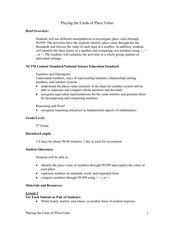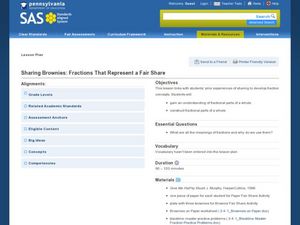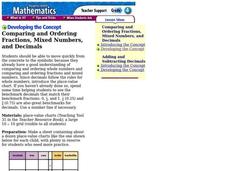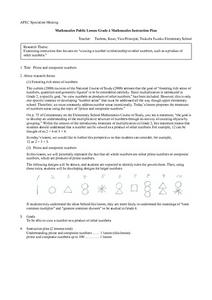Curated OER
Playing the Cards of Place Value
Third graders explore place value to the ten-thousands place. In this amazing, 21-page place value lesson, learners represent numbers in standard and expanded form, and use technology to represent numbers to 9,999.
Curated OER
Place Value of Whole Numbers Through One Million
Third graders construct numbers to the millions place. In this 30-page place value lesson, learners create numbers and evaluate the place value of digits. They explore standard and expanded form of numbers. An incredible resource!
Alabama Learning Exchange
Imaginary Numbers? What Do You Mean Imaginary?
Don't worry, this resource actually exists. Scholars learn about imaginary numbers and work on problems simplifying square roots of negative numbers. As an extension, they research the history of imaginary numbers.
Curated OER
Building Numbers to 50
Students explore how to represent numbers using cubes and draw them accordingly. They discuss place value and the base ten number system using manipulatives. Students roll a dice and take that many blocks. They write down their resulting...
Curated OER
Learning Even and Odd Numbers
In this math lesson, young learners receive a numeral written on a paper and arrange themselves in chronological order. They illustrate skip counting by 2's, 5's, and 10's using their numerals and then complete an individual 100 chart by...
EngageNY
Even and Odd Numbers
Even or not, here I come. Groups investigate the parity of products and sums of whole numbers in the 17th lesson plan in a series of 21. Using dots to represent numbers, they develop a pattern for the products of two even numbers; two...
Illustrative Mathematics
Naming the Whole for a Fraction
How many different ways can you represent a whole? In a picture that represents six parts (two of which are shaded), learners are asked to label the parts appropriately to show how three different mathematical interpretations can be...
Curated OER
Powers and Roots of Complex Numbers
Explore a few powers of complex numbers numerically and decide if there is a pattern and use parametric equations to represent a complex number graphically. Use De Moivre's theorem to represent the roots of the complex number...
Curated OER
Sharing Brownies: Fractions That Represent a Fair Share
Elementary graders discover the concept of fractional pieces of a whole. They investigate the meanings of fractions in everyday life and why they are used. Pupils divide brownies amongst each other to demonstrate the use of fractions...
Curated OER
Plotting Numbers and Test
Sixth graders create a human number line. They determine the correct placement of various numbers ranging from -4 to 4. Additionally, they will determine the placement of numbers written as fractions and/or decimals.
Curated OER
Comparing and Ordering Fractions, Mixed Numbers, and Decimals
Create your own fraction kits by folding and labeling paper using fraction vocabulary. Learners then work in groups to use these in comparing and sequencing both whole numbers and fractions. They also create unit cubes and develop an...
Illustrative Mathematics
Irrational Numbers on the Number Line
There are four irrational numbers that participants need to graph. Pi(π), -(½ x π), and √17 are easy to approximate with common rational numbers. On the other hand, the commentary describing the irrational number 2√2 is not clear. It...
Curated OER
Skittles Galore!
Youngsters show understanding of accurate division of whole number, decimals, fractions, and percents using manipulatives (candies). They use white boards to demonstrate their understanding of representing numbers as defined in the...
EngageNY
An Appearance of Complex Numbers 2
Help the class visualize operations with complex numbers with a lesson that formally introduces complex numbers and reviews the visualization of complex numbers on the complex plane. The fifth installment of a 32-part series reviews the...
Illustrative Mathematics
Number of the Day
Daily routines not only help to manage classrooms, they can also provide students with rich opportunities for learning. This activity supports young learners in developing their number sense by counting up the school days on a class 100...
Curated OER
Number and Operations: Webbing Our Way Through Numbers
Second graders explore estimation and place value. In this place value activity, 2nd graders estimate and construct numbers while working with spider activities. Students use addition and subtraction to compare estimates. Resources and...
Curated OER
All Kinds of Numbers
Count and compare numbers and fractions using "greater than" and "less than." Learners count on by 2s and 10s and represent the end number with base ten blocks, counters, and cups. They use circle stickers to illustrate fractions and...
Alabama Learning Exchange
As If Numbers Weren't Complex Enough Already!
The class explores the concept of complex numbers on a website to generate their own Mandelbrot sets. They will practice performing operations with complex numbers and then to get a visual understanding, graph the absolute value of a...
National Security Agency
Let's Party With Place Value
Put on your math caps and explore place value and ways to represent numbers. Learners read, write, and represent whole numbers. They interact with numbers as they read and explore a teacher-created story, play games, and practice their...
Curated OER
Many Ways to Represent Our Data
Demonstrate several ways to represent data with your class. They will use surveys to gather data and display the data using tally charts and graphs. Then answer questions according to the data.
Curated OER
Comparing and Ordering Fractions, Mixed Numbers, and Decimals
Students practice comparing and ordering fractions, mixed numbers, and decimals. In this fractions, mixed numbers, and decimals lesson, students examine a decimal place value chart compared to a whole number place value chart. They...
Curated OER
Prime And Composite Numbers - Fuzoku Elementary
Fourth graders investigate the concept of prime and composite numbers. Students study the visual representation for the numbers and use the pictures in order to develop designs for larger numbers. The goal of the lesson is for them to...
Curated OER
Ordering Rational Numbers and Finding Their Approximate
Middle schoolers explore the concept of ordering rational numbers on a number line. They represent rational numbers as decimals and percents. Pupils create a foldable about converting fractions to decimals to percents, and use a...
Curated OER
Add It Up In Number Ville! Adding 2-Digit Numbers With and Without Regrouping
Students explore adding 2-digit numbers. In this math lesson, students identify 2-digit numbers and use base ten blocks to practice adding. Students use addition to break a code.

























